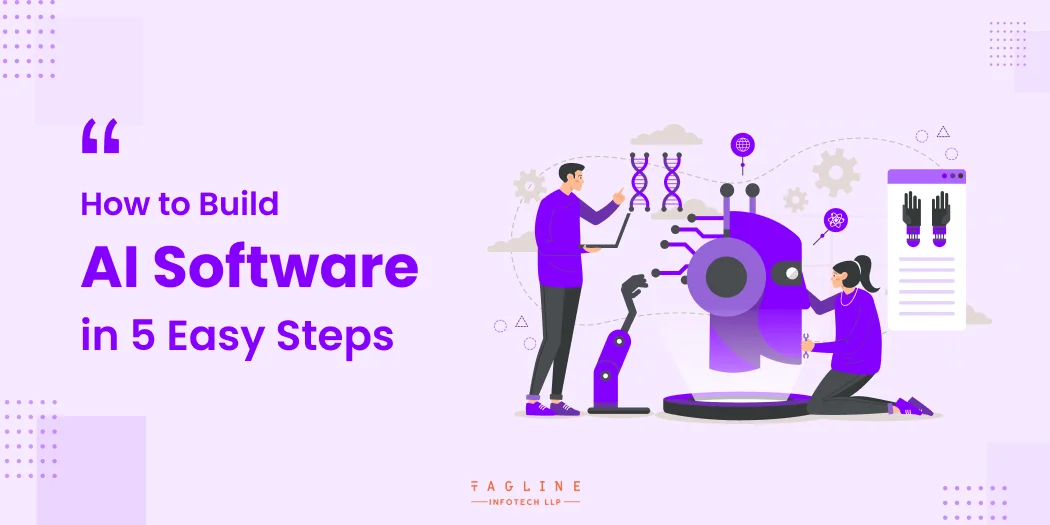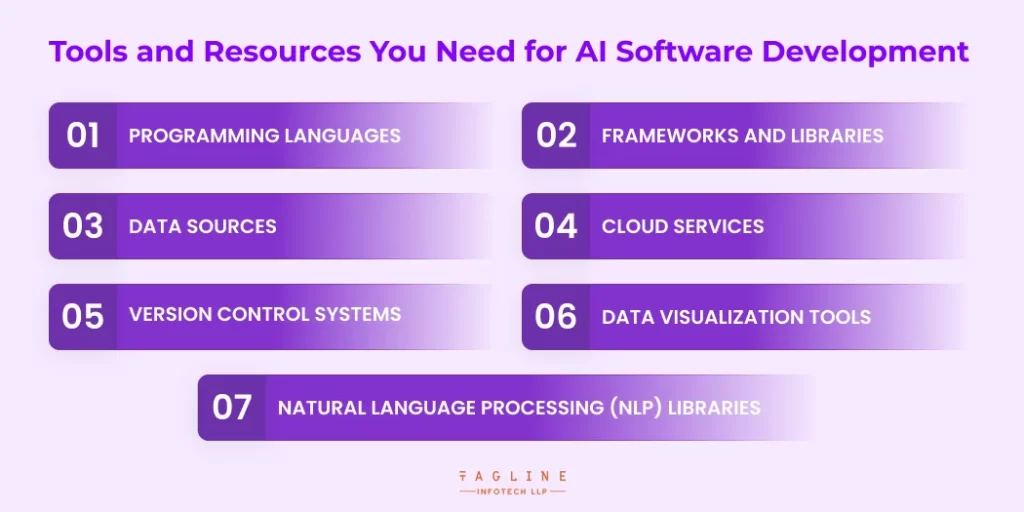Role of Python Libraries in Image Processing
October 30, 2025
Home >> AI >> How to Build AI Software in 5 Easy Steps

Building AI software may seem easy, but getting it right can be expensive. This article is here to answer your basic questions about building an AI system from scratch, with some additional tips to help you get started. AI is everywhere these days—it’s hard to miss. Tesla uses AI to change the game in self-driving cars, while local hospitals use it to facilitate appointments. Globally, 83% of organizations now see AI as their key to increasing innovation. With all this talk about AI, you might be thinking your business should jump in. You might feel like you’re missing out, or the benefits just seem too good to ignore. So, you may be asking yourself—how do I even begin to Build A Generative AI system? This is a big decision, and you want to ensure you get it right. With so much at stake—your time, money, and reputation—you must be confident in your next step.
Using AI software can boost a business by solving different problems with the right technology. Understanding how to develop AI software is crucial for leveraging these technologies effectively. Virtual assistants, like chatbots and voice-controlled devices, make customer service easier and more efficient. Personalized recommendations, powered by smart algorithms, help customers find the right products or content, making shopping and streaming more enjoyable. Workflow automation tools like RPA and OCR take care of routine tasks like processing invoices or generating reports, saving time and effort. Image recognition technology, used in security systems and self-driving cars, ensures safety and quality. Predictive analytics helps businesses forecast sales, manage risks, and keep equipment running smoothly. Autonomous systems like drones and warehouse robots are becoming smarter with AI, making operations more efficient. Fraud detection tools protect against scams and identity theft, while sentiment analysis helps businesses understand what customers are saying online and manage their reputation. For media and entertainment, an AI Lip Sync Video Generator can enhance video content creation by ensuring realistic synchronization of audio and video, providing an immersive experience for viewers.

Choosing the right tools and technologies is important when learning how to make AI software. Even the best ideas can fail without the right resources. The equipment you choose will greatly affect your success.
Here is a quick guide to the technology required to create an AI system.

In the fast-paced digital world we live in, artificial intelligence has emerged as an important force driving innovation across industries. However, a recent survey by IBM highlights a notable difference: while 59% of AI professionals are actively implementing AI solutions, 40% of organizations are still engaged in the discovery phase, and they are struggling with many developmental challenges.
The combination of technical expertise and business expertise is essential to optimizing AI software and creating solutions that are efficient, secure, and aligned with business objectives.
AI can tackle a wide range of issues, so the first step is to pinpoint the specific problem you want to address. Clearly defining the business case is vital, as it lays the foundation for the entire project. Here’s an alternative example to demonstrate the significance of this step:
Consider that you operate a small fitness app and have noticed a significant drop in user engagement after the initial sign-up phase. Here’s how you can frame the potential of AI in this situation:
Data serves as the foundation for any AI system. Following the 10x rule, it’s generally recommended to have at least ten examples for each feature to ensure robust model training. The quality of the data you collect is crucial for developing accurate AI models. At this stage, your goal is to gather both structured data (such as text files, spreadsheets, and records) and unstructured data (like images and audio) from a variety of sources. You can leverage existing datasets or create new ones through surveys, experiments, or data scraping tools.
Here are the key steps involved:
Raw data is often cluttered with errors, inconsistencies, and missing values. The data cleaning process involves preprocessing and transforming the data to enhance its quality and reliability.
Once the data is cleaned, the next step is feature engineering. This involves selecting, extracting, and creating meaningful features from the raw data, enabling the AI models to make informed predictions or classifications.
Utilizing data pipelines can significantly streamline this entire process, as many companies have reported the ability to process millions of data files in mere milliseconds. This efficiency not only accelerates development but also enhances the overall performance of your AI systems.
Selecting the appropriate algorithms is crucial and varies depending on the type of software development you are undertaking, whether it involves generative models, deep learning, or traditional machine learning techniques.
The development and training of your AI model is arguably the most crucial stage in the AI software development lifecycle. This is the moment when the chosen algorithm begins to learn from the data you’ve meticulously prepared, enabling it to make informed predictions or decisions.
Here’s a straightforward breakdown of the process:
Once you’ve trained and tested your AI model, the next step is to ensure it’s accessible and functional for end-users. A common approach is to develop an Application Programming Interface (API) that facilitates communication between different software components. By hosting your AI model on a server, your application can send requests to the model and receive predictions in return.
Alternatively, you may choose to embed the AI model directly within the software, particularly in mobile applications or offline solutions that require real-time predictions without relying on an internet connection. It’s crucial to ensure that the AI features are seamlessly integrated into the user interface.
For instance, if you’re incorporating a recommendation engine into an eCommerce platform, users should easily see personalized recommendations displayed on product pages or during the checkout process. This integration enhances the user experience and maximizes the effectiveness of your AI solution.
While the potential of AI-driven software development is exciting and transformative, it’s important to acknowledge the challenges that often accompany such innovations. Understanding how to make an AI software involves navigating these challenges to successfully harness the power of artificial intelligence.
Here are some common obstacles you might face during the development process:
Many people believe that building AI software is prohibitively expensive, but that’s not necessarily true. While it typically requires a higher investment than traditional technologies or standard products, it remains within reach for small and medium-sized businesses.
The overall cost will depend on several factors and can vary significantly based on your project’s specific requirements. For instance, data collection and preparation can range from $10,000 to $80,000. Algorithm and model development may cost between $35,000 and $120,000, while the necessary infrastructure and tools can add another $5,000 to $50,000. When it comes to integration and deployment, expect to invest anywhere from $70,000 to over $200,000. Additionally, annual maintenance and updates can range from $20,000 to $60,000.
In total, the estimated cost of developing AI software can fall between $130,000 and $500,000 or more. This breakdown provides valuable insight into the potential investment needed for your AI projects, helping you make more informed decisions.
The recent breakthroughs in top artificial intelligence Applications are nothing short of revolutionary, continuously impressing both businesses and individuals with their ability to analyze, predict, automate, and simplify our daily lives. It’s no surprise that many are eager to embark on the journey of AI software development.
However, before diving in, it’s essential to address several critical aspects to ensure your AI software is effective, ethical, and genuinely valuable. Here are some vital questions to guide you through the development process:
Is your data clean, accurate, and relevant? Consider whether there are any missing values or outliers that could compromise your model’s performance.
Have you examined your training data for biases? What measures are you taking to address and mitigate any potential bias in your AI system?
How are you safeguarding user data? Are you adhering to data protection regulations such as GDPR? Additionally, have you implemented encryption and anonymization practices to protect sensitive information?
Can your AI system efficiently manage increasing volumes of data and users? Have you designed your infrastructure to scale seamlessly as demand grows?
Have you thought about the ethical implications of your AI system? Is your AI being utilized responsibly to prevent any harm to individuals or communities?
By addressing these key questions, you can create an AI solution that not only meets technical requirements but also aligns with ethical standards and user expectations.
In the modern pace of rapid technology change, many have been lured by the promise of AI software development, but few have ever managed to fully master it. To build such advanced solutions requires a huge upfront investment. Advanced technologies need to be adopted by your team, while organizational data has to be managed comprehensively and your staff trained to efficiently handle AI systems.
Overwhelmed? Perfectly understandable. The process can be very intricate and intimidating. If you’re wary of starting on your own, consider joining up with an experienced AI software development team. Starting small with expert guidance can pave the way for substantial progress in the future.
Here at Tagline Infotech, we are committed to guiding you through every step. Whether it is a full development service or just some expert advice, we’re here to make your dream a reality.
Developing AI software can be an exciting but overwhelming journey. With the power to transform business, drive efficiency, and force growth, investment in AI is a strategic business decision for progressive companies. However, treading the complex landscape of AI requires a great deal of thoughtful planning and an equally robust ethical framework.
This is where identifying and Hiring AI developers will help you take advantage of the AI services offered by Tagline Infotech. A veteran team will impart knowledge and extend the required support in turning your ideas into action, guiding how effective a solution with AI will be scalable and will also align with best practices. Let us empower you to unlock the full potential that AI has in store for your business.
Costs range from $130,000 to over $500,000, depending on various factors.
Challenges include data quality, bias, security, resource constraints, and model complexity.
Regularly check for biases in data and consider ethical implications throughout development.
Tagline Infotech offers experienced AI developers to help you create effective and scalable AI solutions.
Created with Solvase

Digital Valley, 423, Apple Square, beside Lajamni Chowk, Mota Varachha, Surat, Gujarat 394101
D-401, titanium city center, 100 feet anand nagar road, Ahmedabad-380015
+91 9913 808 2851133 Sampley Ln Leander, Texas, 78641
52 Godalming Avenue, wallington, London - SM6 8NW